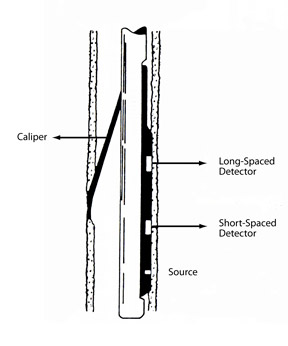Hostile Environment Lithodensity Tool (HLDT*)
Description
137Cs radioactive source and two detectors mounted on a shielded skid which was pressed against the formation by a hydraulically-activated eccentering arm. The 662 keV gamma rays emitted by the source into the formation experienced two types of interaction with the electrons in the formation: Compton scattering and photoelectric absorption. The former is an elastic collision by which energy is transferred from the gamma ray to the electrons in the formation. This interaction forms the basis of the density measurement; in fact, because the number of scattered gamma rays that reach the detectors is directly related to the number of electrons in the formation, the tool responded to the electron density of the rocks, which is in turn related to the bulk density.
The former is an elastic collision by which energy is transferred from the gamma ray to the electrons in the formation. This interaction forms the basis of the density measurement; in fact, because the number of scattered gamma rays that reach the detectors is directly related to the number of electrons in the formation, the tool responded to the electron density of the rocks, which is in turn related to the bulk density.
Photoelectric absorption, on the other hand, occurs when the gamma rays reach a low energy (<150 keV) level after being repeatedly scattered by the electrons in the formation. The photoelectric effect index was determined by comparing the counts from the far detector in the high energy region, where only Compton scattering occurs, with those in the low energy region, where the count rates depended on both reactions. The far detector was used because it had a greater depth of investigation. The response of the short-spacing detector, which was mostly influenced by mudcake (not present in ODP boreholes where a seawater-based drilling fluid was used), and borehole rugosity were used to correct the density measurement for these effects.
The HLDT was used during ODP from Leg 125 to Leg 206.
Applications
Porosity. If grain density is known, porosity can be calculated from the density log. Alternatively, porosity and density logs can together be used to calculate grain density.
Seismic impedance. The product of velocity and density can be utilized as input to synthetic seismogram computations.
Lithology androck chemistry definition. In combination with the neutron log, the density log allows for the definition of the lithology and of lithologic boundaries. Because each element is characterized by a different photoelectric factor, this can be used, alone or in combination with other logs, to determine the lithologic type. Both density and photoelectric effect index are input parameters to some of the geochemical processing algorithms used onshore.
Environmental Effects
A reliable density measurement requires good contact between pad and formation. Because a caliper measurement was made during the recording, it was possible to check the quality of the contact. In the HLDT the presence of mudcake and hole irregularities were automatically accounted for using a “spine and ribs” chart based on a series of laboratory measurements. The “spine” was the locus of the two counting rates (short and long spacing) without mudcake and the “ribs” traced out the counting rates for the presence of mudcake at a fixed formation density. The short and long spacing readings were automatically plotted on this chart and corrected for their departure from true value. These corrected data were typically located in the DRHO data column.
Log Presentation
The primary curves were: bulk density (RHOB, in g/cm³), photoelectric effect (PEFL, in barns/electron) density correction (DRHO, in g/cm³), and caliper (CALI, in in.). They were
usually displayed along with the neutron curve NPHI. Also, DPHI (density porosity) could be computed and displayed by assuming a constant grain density of the matrix. DRHO was useful for quality control of the data; if the tool was operating correctly it should be less than 0.1 g/cm³.
Tool Specifications
| Temperature rating: | 500° F (260° C) |
| Pressure rating: | |
| Diameter: | 3.5 in (8.9 cm) |
| Length: | 23.08 ft (7.03 m) |
| Sampling interval: | 6 in (15.24 cm) |
Measurement Specifications
| Vertical resolution: | 1.25 ft (38 cm) |
| Max. logging speed: | 1800 ft/hr (548.6 m/hr) |
Major Outputs
| CALI: |
Caliper (in)
|
| DRHO: | Bulk density correction (g/cm3) |
| PEF: | Photoelectric effect (barns/e–) |
| RHOB: | Bulk density (g/cm3) |
| HDRH: | High res density correction (g/cm3) |
| HPEF: | High res photoelectric effect (barns/e–) |
| HRHO: | High res bulk density (g/cm3) |
Deployment Notes
The HLDT was typically run with the NGT/HNGS, DIT and APS tools.
* ®trademark of Schlumberger
